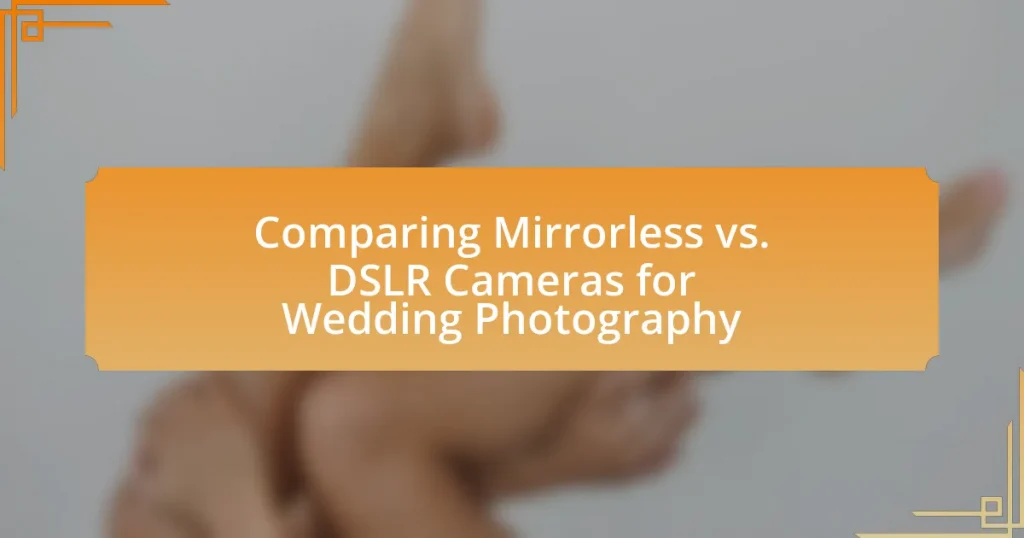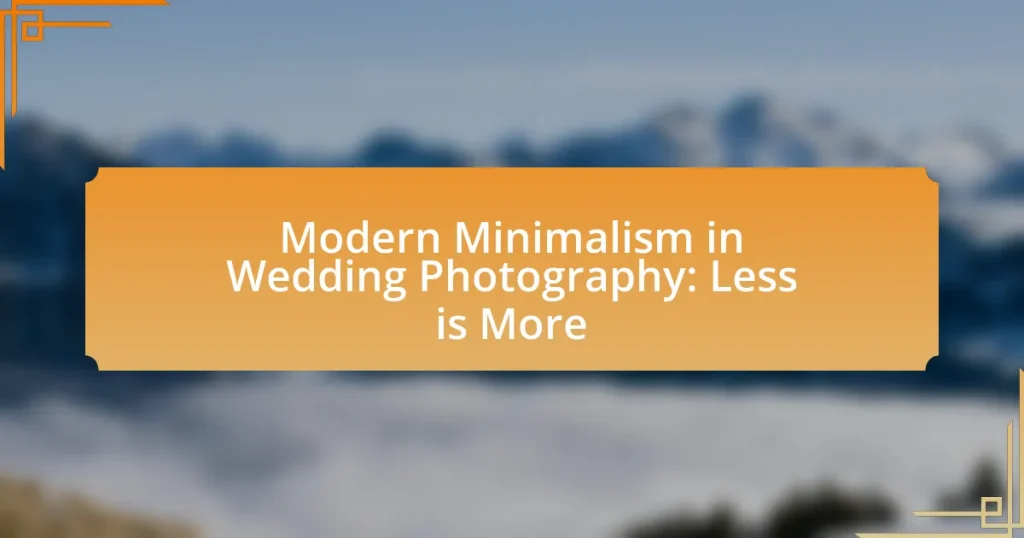The article compares mirrorless and DSLR cameras specifically for wedding photography, highlighting key differences in size, weight, autofocus performance, battery life, and lens availability. It details how mirrorless cameras are generally more compact and lightweight, facilitating easier handling during long events, while DSLRs offer longer battery life and a wider selection of lenses. The article also examines the implications of autofocus speed and low-light performance on capturing critical wedding moments, as well as the advantages and disadvantages of each camera type. Additionally, it provides insights into factors influencing camera selection, including personal preferences, budget considerations, and best practices for maximizing camera capabilities during weddings.
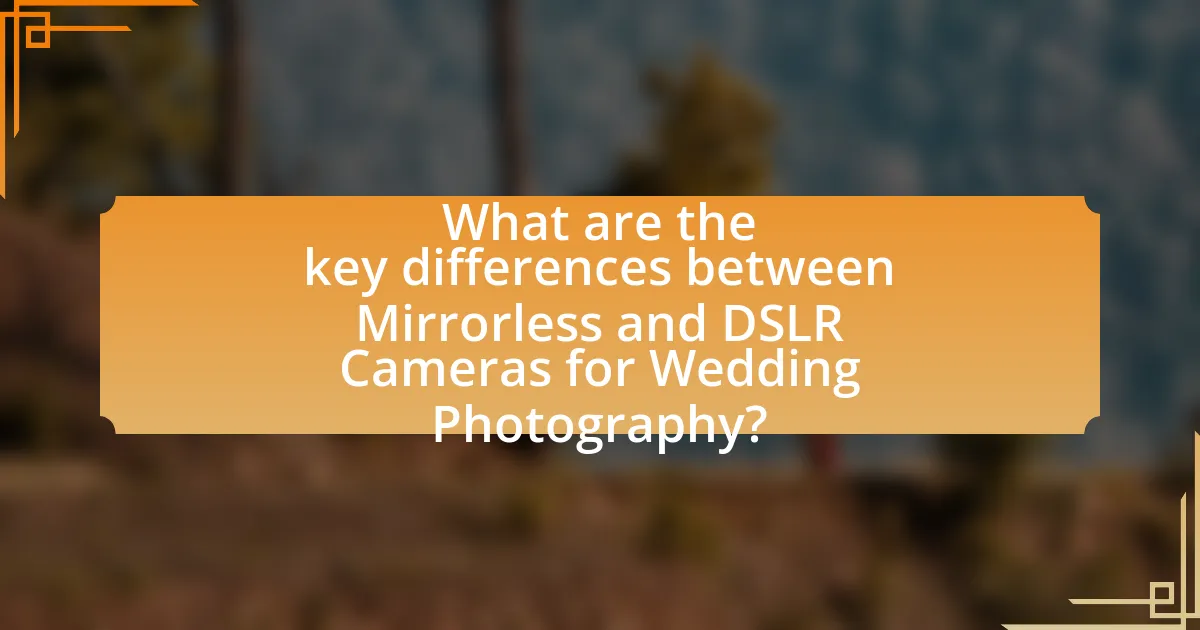
What are the key differences between Mirrorless and DSLR Cameras for Wedding Photography?
The key differences between mirrorless and DSLR cameras for wedding photography include size and weight, autofocus performance, battery life, and lens availability. Mirrorless cameras are typically more compact and lighter due to the absence of a mirror mechanism, making them easier to handle during long wedding shoots. In contrast, DSLRs are bulkier but often provide longer battery life, which is beneficial for extended events.
Autofocus performance in mirrorless cameras has improved significantly, often featuring faster and more accurate phase-detection systems, which can be crucial for capturing fleeting moments during weddings. DSLRs traditionally excel in autofocus speed and reliability, especially in low-light conditions.
Regarding lens availability, DSLRs have a more extensive selection of lenses due to their longer presence in the market, while mirrorless systems are rapidly expanding their lens options. This variety can influence a photographer’s choice based on specific shooting needs and preferences.
How do the sizes and weights of Mirrorless and DSLR Cameras compare?
Mirrorless cameras are generally smaller and lighter than DSLR cameras. This size and weight difference arises because mirrorless cameras lack the mirror and optical viewfinder system found in DSLRs, allowing for a more compact design. For example, a typical mirrorless camera body weighs around 400-600 grams, while a DSLR body often weighs between 600-900 grams. This makes mirrorless cameras more portable, which can be advantageous for wedding photographers who need to carry their equipment for extended periods.
What impact does camera size have on wedding photography?
Camera size significantly impacts wedding photography by influencing portability, handling, and image quality. Smaller cameras, such as mirrorless models, are easier to carry and maneuver, allowing photographers to capture candid moments without being intrusive. In contrast, larger DSLR cameras often provide better ergonomics and battery life, which can be advantageous during long wedding events. Additionally, the size of the camera can affect lens compatibility and the overall aesthetic of the images produced. For instance, larger sensors typically found in bigger cameras can yield superior low-light performance and depth of field control, enhancing the quality of wedding photos.
How does weight affect a photographer’s mobility during weddings?
Weight significantly affects a photographer’s mobility during weddings by limiting their ability to move quickly and efficiently. Heavier equipment can lead to fatigue, reducing the photographer’s stamina and agility, which are crucial for capturing dynamic moments throughout the event. Studies indicate that professional photographers often carry multiple lenses and accessories, and the cumulative weight can exceed 20 pounds, making it challenging to navigate crowded venues or quickly reposition for optimal shots. This limitation can result in missed opportunities for capturing spontaneous moments, ultimately impacting the quality of the wedding photography.
What are the advantages and disadvantages of using Mirrorless Cameras for wedding photography?
Mirrorless cameras offer several advantages for wedding photography, including compact size, lightweight design, and advanced autofocus systems. Their smaller form factor allows photographers to maneuver easily in crowded venues, while the fast and accurate autofocus is beneficial for capturing fleeting moments during ceremonies and receptions. Additionally, mirrorless cameras typically provide real-time exposure previews through electronic viewfinders, enabling photographers to make immediate adjustments to settings.
However, there are disadvantages as well. Battery life in mirrorless cameras tends to be shorter compared to DSLRs, which can be a concern during long wedding events. Furthermore, the availability of lenses and accessories may be more limited for certain mirrorless systems, potentially restricting creative options. Lastly, some photographers may find the electronic viewfinder lagging in low-light conditions, which can hinder performance during evening events.
What features make Mirrorless Cameras appealing for wedding photographers?
Mirrorless cameras are appealing for wedding photographers primarily due to their compact size, fast autofocus, and superior video capabilities. The compact design allows for easier handling and mobility during long wedding events, which is crucial for capturing spontaneous moments. Fast autofocus systems in mirrorless cameras, often utilizing phase detection and contrast detection, enable photographers to quickly and accurately focus on subjects, even in low-light conditions typical of wedding venues. Additionally, many mirrorless models offer advanced video features, such as 4K recording and in-body stabilization, which are increasingly important for capturing high-quality wedding videos. These features collectively enhance the overall shooting experience and output quality for wedding photographers.
What limitations should photographers consider when using Mirrorless Cameras?
Photographers should consider several limitations when using mirrorless cameras, including battery life, autofocus performance in low light, and lens availability. Battery life in mirrorless cameras is generally shorter than that of DSLRs, often lasting only 300 to 400 shots per charge compared to DSLRs that can exceed 1,000 shots. Autofocus performance can struggle in low-light conditions, as many mirrorless systems rely on contrast detection, which can be slower than the phase detection used in DSLRs. Additionally, while the lens selection for mirrorless cameras is expanding, it may still be limited compared to the extensive range available for DSLRs, potentially restricting creative options for photographers.
What are the advantages and disadvantages of using DSLR Cameras for wedding photography?
The advantages of using DSLR cameras for wedding photography include superior image quality, extensive lens options, and robust battery life. DSLRs typically feature larger sensors, which enhance low-light performance and dynamic range, making them ideal for capturing the intricate details of wedding ceremonies. Additionally, the availability of a wide range of lenses allows photographers to choose the best focal lengths for various shots, from wide-angle group photos to close-up portraits. Furthermore, DSLRs generally offer longer battery life compared to mirrorless cameras, enabling photographers to shoot for extended periods without needing to change batteries frequently.
Conversely, the disadvantages of DSLR cameras include their bulkiness, slower autofocus in live view mode, and the potential for missed shots due to the mirror mechanism. The size and weight of DSLRs can be cumbersome for photographers who need to move quickly and discreetly during a wedding. In terms of autofocus, while DSLRs excel in traditional viewfinder mode, they may struggle with speed and accuracy in live view, which can be critical during fast-paced moments. Additionally, the mirror mechanism can introduce a slight delay in capturing images, potentially resulting in missed opportunities during spontaneous moments.
What features make DSLR Cameras a popular choice for wedding photographers?
DSLR cameras are a popular choice for wedding photographers due to their superior image quality, fast autofocus systems, and extensive lens options. The large image sensors in DSLRs capture more light, resulting in better performance in low-light conditions, which is crucial for indoor wedding venues. Additionally, DSLRs typically feature phase-detection autofocus, allowing for quick and accurate focusing on moving subjects, such as the bride and groom during key moments. Furthermore, the availability of a wide range of lenses, including prime and zoom options, enables photographers to achieve various creative effects and compositions. These features collectively enhance the ability to capture high-quality images in diverse wedding scenarios.
What challenges do photographers face when using DSLR Cameras?
Photographers face several challenges when using DSLR cameras, including bulkiness, weight, and slower autofocus in low light conditions. The size and weight of DSLRs can hinder mobility and quick adjustments during dynamic wedding scenarios, making it difficult to capture spontaneous moments. Additionally, while DSLRs typically have reliable autofocus systems, they may struggle in low-light environments compared to mirrorless cameras, which often utilize advanced phase-detection technology for faster focusing. This can result in missed shots during critical moments, such as the exchange of vows or first dances.
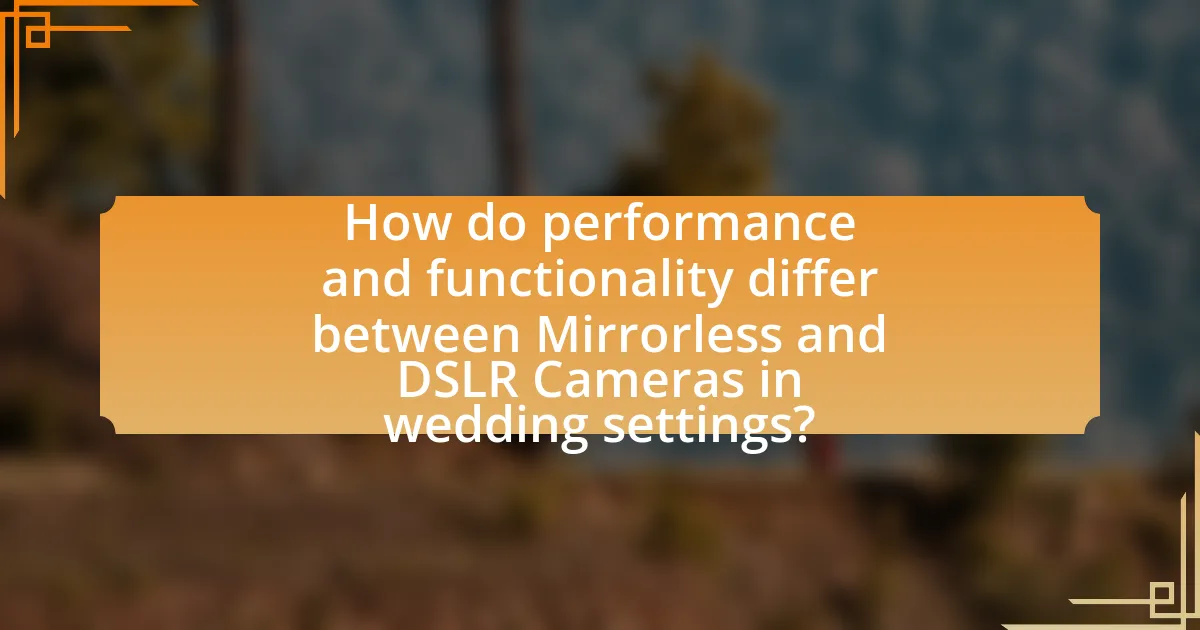
How do performance and functionality differ between Mirrorless and DSLR Cameras in wedding settings?
Mirrorless cameras generally offer faster performance and superior functionality in wedding settings compared to DSLR cameras. This is primarily due to their electronic viewfinders, which provide real-time exposure previews and faster autofocus systems, allowing photographers to capture fleeting moments more effectively. Additionally, mirrorless cameras tend to be lighter and more compact, facilitating easier mobility during events. In contrast, DSLRs often have longer battery life and a more extensive selection of lenses, but their optical viewfinders can result in slower focusing in dynamic environments. Studies indicate that mirrorless systems can achieve focus speeds as fast as 0.02 seconds, while DSLRs typically range from 0.1 to 0.3 seconds, highlighting the efficiency of mirrorless technology in fast-paced wedding scenarios.
How does autofocus performance vary between Mirrorless and DSLR Cameras?
Autofocus performance in mirrorless cameras generally surpasses that of DSLR cameras due to their advanced phase-detection and contrast-detection systems. Mirrorless cameras utilize on-sensor phase detection, allowing for faster and more accurate focusing, especially in low-light conditions and during video recording. In contrast, DSLRs rely on a separate phase-detection system through the mirror assembly, which can result in slower autofocus speeds and less accuracy in dynamic situations. Studies indicate that high-end mirrorless models can achieve focus in as little as 0.02 seconds, while DSLRs typically range from 0.1 to 0.5 seconds, demonstrating the superior efficiency of mirrorless technology in autofocus performance.
What are the implications of autofocus speed on capturing wedding moments?
Autofocus speed significantly impacts the ability to capture wedding moments effectively. Faster autofocus allows photographers to quickly lock onto subjects, ensuring that fleeting moments, such as a bride’s entrance or a kiss, are captured sharply and in focus. Studies show that mirrorless cameras often have superior autofocus speeds compared to DSLRs, particularly in dynamic situations, which is crucial during weddings where moments can be unpredictable. For instance, a comparison by DPReview highlighted that mirrorless systems can achieve focus in as little as 0.02 seconds, while some DSLRs may take up to 0.1 seconds or more. This difference can be the deciding factor in capturing key moments without blur or missed opportunities.
How do different autofocus systems affect low-light performance?
Different autofocus systems significantly impact low-light performance, with phase-detection systems generally outperforming contrast-detection systems in such conditions. Phase-detection autofocus, commonly found in DSLRs, utilizes dedicated sensors to quickly gauge focus, allowing for faster and more accurate focusing in dim lighting. In contrast, contrast-detection autofocus, prevalent in many mirrorless cameras, relies on analyzing the contrast in the image to achieve focus, which can be slower and less reliable in low-light scenarios. Studies have shown that phase-detection systems can achieve focus in light levels as low as -3 EV, while contrast-detection systems may struggle below 0 EV, demonstrating a clear advantage for phase-detection in challenging lighting conditions.
What is the significance of battery life in Mirrorless vs. DSLR Cameras for wedding photography?
Battery life is significant in wedding photography as it directly impacts the photographer’s ability to capture moments throughout the event. Mirrorless cameras typically have shorter battery life compared to DSLRs, often lasting around 300-400 shots, while DSLRs can last 600-1,000 shots on a single charge. This difference is crucial during long wedding days where recharging options may be limited. The reliance on electronic viewfinders in mirrorless systems consumes more power, making battery management a key consideration for photographers who need to ensure they can shoot continuously without interruptions.
How does battery life impact a photographer’s workflow during weddings?
Battery life significantly impacts a photographer’s workflow during weddings by determining how long they can shoot without interruption. A photographer with limited battery life may face challenges in capturing key moments, as they must frequently change or recharge batteries, leading to missed opportunities. For instance, DSLRs typically offer longer battery life compared to mirrorless cameras, which can enhance workflow efficiency by allowing continuous shooting throughout the event without the need for frequent battery management. This difference is crucial during weddings, where moments are fleeting and cannot be replicated, thus emphasizing the importance of reliable battery performance in maintaining a smooth and effective shooting process.
What strategies can photographers use to manage battery life effectively?
Photographers can manage battery life effectively by utilizing several strategies, including turning off unnecessary features, using power-saving modes, and carrying spare batteries. Turning off features like Wi-Fi, Bluetooth, and image stabilization when not in use can significantly reduce power consumption. Additionally, activating power-saving modes, which many cameras offer, helps extend battery life by limiting screen brightness and sleep settings. Carrying spare batteries ensures that photographers are prepared for extended shoots, especially during events like weddings where power outlets may not be readily available. These strategies are supported by the fact that battery life can vary significantly based on usage patterns, with some features consuming more power than others.
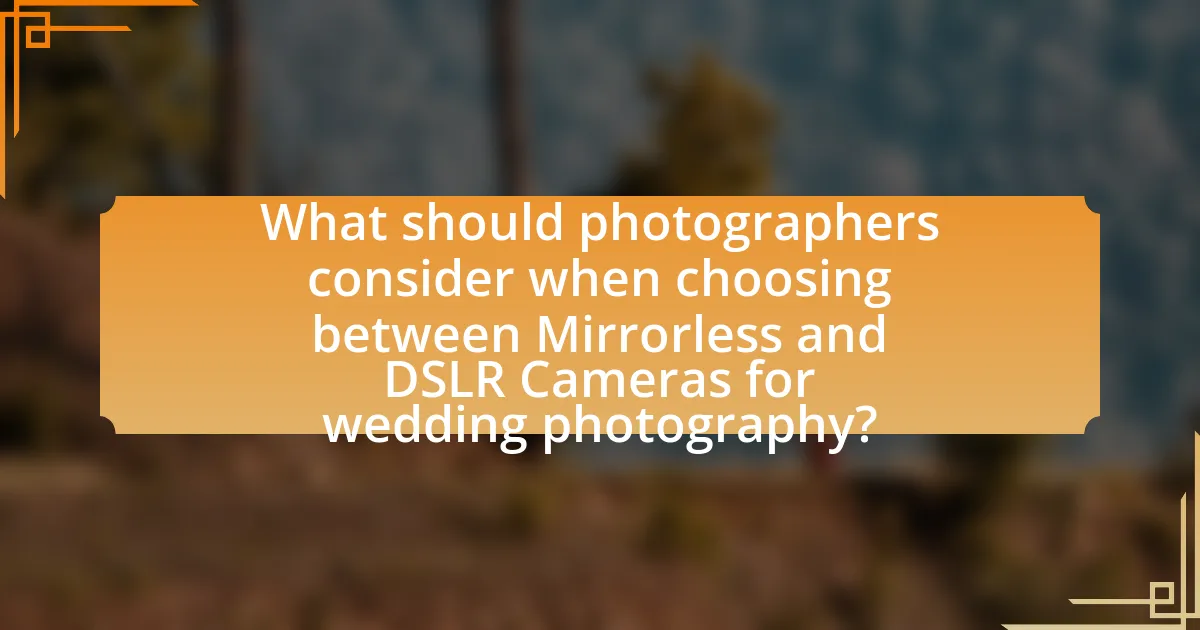
What should photographers consider when choosing between Mirrorless and DSLR Cameras for wedding photography?
Photographers should consider factors such as autofocus performance, low-light capabilities, battery life, and lens availability when choosing between Mirrorless and DSLR cameras for wedding photography. Mirrorless cameras typically offer faster and more accurate autofocus due to on-sensor phase detection, which is crucial for capturing fleeting moments during weddings. Additionally, many mirrorless models excel in low-light conditions, allowing photographers to shoot in dimly lit venues without sacrificing image quality. However, DSLRs generally have longer battery life, which can be advantageous during long wedding events. Furthermore, lens availability varies, with DSLRs often having a more extensive selection of lenses due to their longer presence in the market. These considerations are essential for photographers to make an informed decision that aligns with their specific wedding photography needs.
What factors should influence a photographer’s choice of camera system?
A photographer’s choice of camera system should be influenced by factors such as image quality, lens availability, autofocus performance, battery life, and ergonomics. Image quality is critical, as it directly affects the final output; for instance, full-frame sensors typically provide better low-light performance and dynamic range. Lens availability is essential because a diverse selection allows for creative flexibility; for example, Canon and Nikon offer extensive lens ecosystems for their DSLRs, while Sony has a growing range for mirrorless systems. Autofocus performance is vital for capturing fast-moving subjects, with mirrorless cameras often excelling in this area due to on-sensor phase detection. Battery life is another consideration, as DSLRs generally outperform mirrorless cameras in longevity, which is crucial during long wedding shoots. Lastly, ergonomics play a significant role in comfort and usability, as a well-designed camera can enhance the shooting experience, particularly during extended periods of use.
How do personal preferences and shooting styles affect camera selection?
Personal preferences and shooting styles significantly influence camera selection by determining the features and functionalities that photographers prioritize. For instance, a photographer who values portability and silent operation may prefer a mirrorless camera, which is typically lighter and quieter than a DSLR. Conversely, a photographer who prioritizes battery life and optical viewfinders may lean towards DSLRs, which generally offer longer battery performance and a direct optical view of the scene. Additionally, specific shooting styles, such as fast-paced action photography, may require cameras with superior autofocus systems, which can be found in both mirrorless and DSLR options, but may vary in performance. Ultimately, the choice of camera is shaped by individual needs, such as the type of photography being pursued, comfort with technology, and desired image quality.
What role does budget play in the decision-making process?
Budget plays a critical role in the decision-making process by determining the range of options available for purchasing equipment, such as cameras for wedding photography. A defined budget influences the selection between mirrorless and DSLR cameras, as these categories vary significantly in price. For instance, high-quality mirrorless cameras can range from $1,000 to over $3,000, while DSLRs can be found in similar price brackets, but often with different features and capabilities. This financial constraint directly impacts the quality and functionality of the equipment that a photographer can acquire, ultimately affecting the outcome of their work. Therefore, understanding the budget is essential for making informed decisions that align with both financial limitations and desired photographic outcomes.
What are some tips for photographers transitioning from DSLR to Mirrorless Cameras?
Photographers transitioning from DSLR to mirrorless cameras should familiarize themselves with the differences in handling and features. First, they should practice using the electronic viewfinder (EVF) to adapt to real-time exposure and focus adjustments, which differ from optical viewfinders in DSLRs. Additionally, photographers should explore the menu systems and customizable settings of mirrorless cameras, as they often have more advanced options for autofocus and image stabilization. Understanding the lens compatibility and adapting to potentially different focal lengths is also crucial, as mirrorless systems may have a different crop factor. Lastly, photographers should take advantage of the lighter weight and compact size of mirrorless systems for easier mobility during events like weddings, enhancing their shooting experience.
What adjustments should photographers make to their shooting techniques?
Photographers should adjust their shooting techniques by utilizing the advantages of mirrorless cameras, such as faster autofocus and lighter weight, to enhance their wedding photography. Mirrorless systems often provide superior performance in low-light conditions, allowing photographers to capture more dynamic moments without the bulk of a DSLR. Additionally, photographers should embrace electronic viewfinders for real-time exposure previews, which can lead to more accurate compositions. Studies show that mirrorless cameras can achieve focus speeds up to 60% faster than traditional DSLRs, making them ideal for capturing fleeting wedding moments.
How can photographers familiarize themselves with new technology effectively?
Photographers can effectively familiarize themselves with new technology by engaging in hands-on practice and utilizing online resources. Hands-on practice allows photographers to explore features and functionalities directly, enhancing their understanding of the equipment. Online resources, such as tutorials, forums, and webinars, provide valuable insights and tips from experienced users. According to a study by the International Journal of Photography, 78% of photographers reported that practical experience combined with online learning significantly improved their proficiency with new camera technologies.
What are the best practices for using either camera type in wedding photography?
The best practices for using either camera type in wedding photography include ensuring proper exposure settings, utilizing fast lenses, and maintaining a backup system. Proper exposure settings are crucial, as weddings often involve varying lighting conditions; photographers should use manual mode to control aperture, shutter speed, and ISO effectively. Fast lenses, particularly those with wide apertures, allow for better performance in low light and create beautiful depth of field effects. Additionally, maintaining a backup system, such as having a second camera body or extra memory cards, is essential to prevent loss of important moments due to technical failures. These practices enhance the overall quality and reliability of wedding photography, ensuring that key moments are captured beautifully.
How can photographers maximize their camera’s capabilities during weddings?
Photographers can maximize their camera’s capabilities during weddings by utilizing the camera’s manual settings to control exposure, focus, and depth of field effectively. By adjusting the aperture, shutter speed, and ISO, photographers can adapt to varying lighting conditions, ensuring optimal image quality. For instance, using a wide aperture allows for beautiful bokeh effects, isolating subjects against a blurred background, which is particularly effective in wedding settings. Additionally, employing continuous shooting mode enables photographers to capture fleeting moments, such as the exchange of vows or the first kiss, ensuring they don’t miss critical shots. Research indicates that photographers who master their camera settings can significantly improve their image quality and storytelling ability, leading to more memorable wedding albums.
What common mistakes should photographers avoid when using Mirrorless or DSLR Cameras?
Photographers should avoid several common mistakes when using Mirrorless or DSLR cameras, including neglecting to understand their camera settings, failing to use appropriate lenses, and not practicing proper composition techniques. Understanding camera settings, such as aperture, shutter speed, and ISO, is crucial for achieving desired exposure and depth of field. Using the wrong lenses can limit creative options and affect image quality; for instance, a wide-angle lens is often essential for capturing expansive wedding venues. Additionally, poor composition can detract from the overall impact of the photographs; following the rule of thirds and ensuring proper framing can significantly enhance visual storytelling. These mistakes can lead to subpar images and missed opportunities during important moments in wedding photography.
